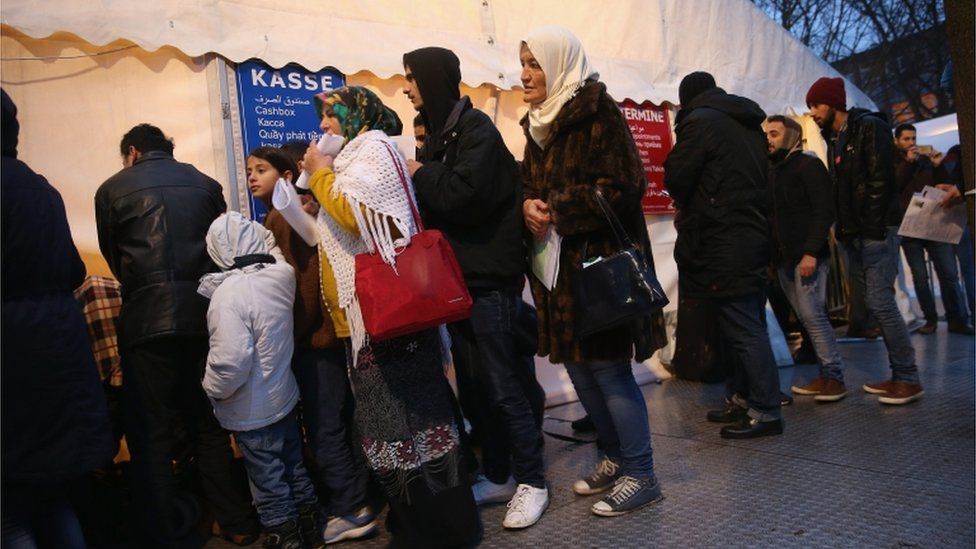This migrant crisis is different from all others
-
Published

As winter has approached, the apparently ceaseless flow of migrants heading for Western Europe has eased off.
But 2015 has unquestionably been the year of the migrant.
The news was dominated for months by pictures of vast crowds shuffling through the borders of yet another European country, being treated with brutality in some places and given a reluctant welcome in others.
In some places - Germany, in particular - the warmth of the welcome they were accorded by some groups compared with the hostility from others.
In researching a report for radio and television about the migrant phenomenon, I was struck again and again by the realisation that there was nothing new about it.
For 100 years, waves of displaced and frightened people have broken over Europe again and again and the images have been strikingly similar each time.
In August 1914, cinema audiences across Britain, many of whom had probably thought this kind of thing would never happen in Europe again, watched jerky black and white newsreel pictures of a million or more Belgians trudging along the roads to the Netherlands or France.
They carried their children and their most treasured possessions, escaping the German soldiers who had invaded their country.
Britain, for its part, took in 250,000 of these Belgian refugees.
During the inter-war years we saw similar pictures from Abyssinia, from Spain, from China and elsewhere, as the future Axis powers sought empire and Lebensraum (territorial expansion).
And then, in 1945, there were exactly the same sort of pictures of the fearful and the homeless, only this time they were of ethnic Germans, 12m of them, forced out of their homes in Poland and Czechoslovakia and Russia and obliged to seek shelter in a shattered and divided Germany.
Post-war migration
Closer to our own time, the pictures are in colour, yet they show the identical problem: terrified Vietnamese refugees escaping from the American bombing, or - after the war had been lost - from the victorious North Vietnamese.
The boat people, fleeing Communism and racial persecution, flooded into Hong Kong and other safe ports, packed on to frail craft that looked like the ones we've seen this year in the waters off Greece, Italy and Turkey.
In the 1970s, Britain took in thousands of the Asian population of Kenya and Idi Amin's Uganda, thrown out of their homes and countries by governments which thought they saw an advantage in driving them away.
There was a bit of antagonism to them in Britain as some people greeted them with placards that read "We Don't Want You" or, more puzzlingly, "Go Home".
But the East African Asians received a fairly generous official welcome and quickly helped to transform British life by setting up small businesses - particularly the corner stores which stayed open in the evenings and weekends, long after the traditional shops closed. The following generation went on to be scientists and teachers and economists - and members of the House of Lords.
More recently, in video of a clarity that makes it look as though it was shot yesterday, we can see floods of ethnic Albanian refugees escaping from the ethnic cleansing of the Serbian forces in Kosovo in 1998 and 1999.
In the footage they come pouring down the steep hillsides, looking like the Belgians of 1914 and the Germans of 1945, with the dull stare of fear and exhaustion in their eyes.
Major difference
Yet there is one major difference between these waves of migrants in the past and the one we have seen in 2015.
Professor Alex Betts, director of the Refugee Studies Centre at Oxford University, explains: "What's dramatic about today is that this is the first time Europe has faced people coming in from the outside in large numbers as refugees.
"The fact that many are Muslims is perceived as challenging Europe's identity."
European societies are changing very fast indeed as a result of immigration.
In London, for instance, more than 300 languages are now spoken, according to a recent academic study and the city's mayor, Boris Johnson.
The influx of migrants reinforces people's sense that their identity is under threat.
But how can the world deal conclusively with the problem?
The former UN under-secretary-general for humanitarian affairs, Sir John Holmes, blames poor global governance.
"Other powers are rising," he says. "And the United States doesn't have the influence it once did - Syria is an example of this - so the problem's not being fixed, no-one's waving the big stick and we're having to pick up the pieces."
We have endured an entire century of exile and homelessness and the cause is almost always the same - conflict and bad government.
Unless these are dealt with, the flow of migrants will never be stopped.